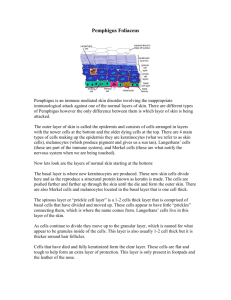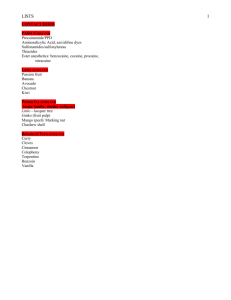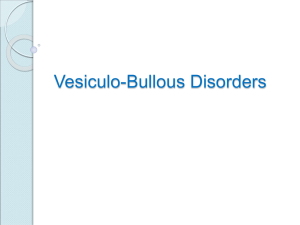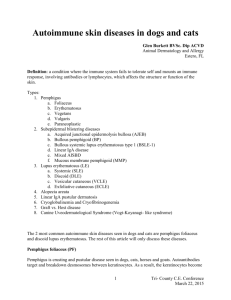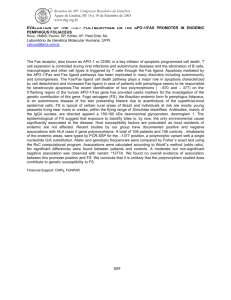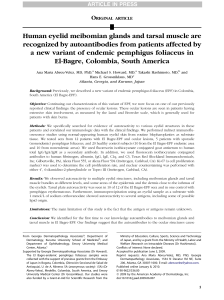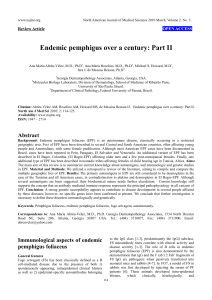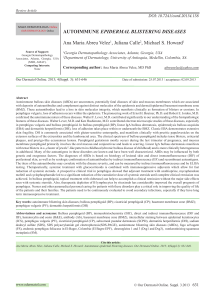Document 14240172
advertisement
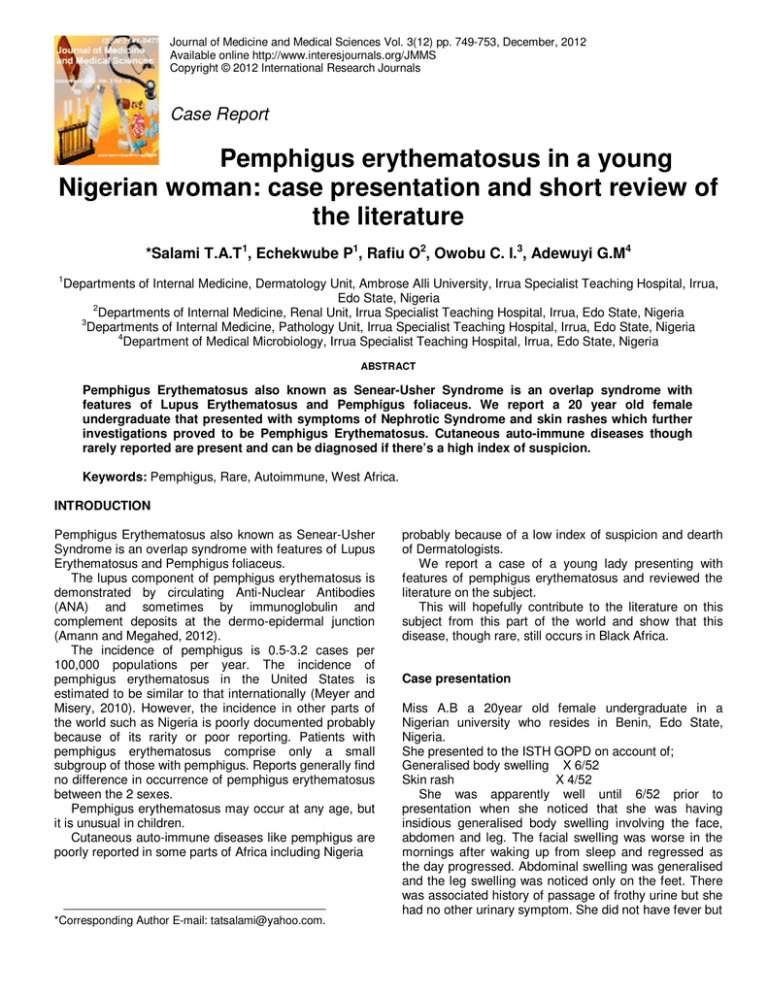
Journal of Medicine and Medical Sciences Vol. 3(12) pp. 749-753, December, 2012 Available online http://www.interesjournals.org/JMMS Copyright © 2012 International Research Journals Case Report Pemphigus erythematosus in a young Nigerian woman: case presentation and short review of the literature *Salami T.A.T1, Echekwube P1, Rafiu O2, Owobu C. I.3, Adewuyi G.M4 1 Departments of Internal Medicine, Dermatology Unit, Ambrose Alli University, Irrua Specialist Teaching Hospital, Irrua, Edo State, Nigeria 2 Departments of Internal Medicine, Renal Unit, Irrua Specialist Teaching Hospital, Irrua, Edo State, Nigeria 3 Departments of Internal Medicine, Pathology Unit, Irrua Specialist Teaching Hospital, Irrua, Edo State, Nigeria 4 Department of Medical Microbiology, Irrua Specialist Teaching Hospital, Irrua, Edo State, Nigeria ABSTRACT Pemphigus Erythematosus also known as Senear-Usher Syndrome is an overlap syndrome with features of Lupus Erythematosus and Pemphigus foliaceus. We report a 20 year old female undergraduate that presented with symptoms of Nephrotic Syndrome and skin rashes which further investigations proved to be Pemphigus Erythematosus. Cutaneous auto-immune diseases though rarely reported are present and can be diagnosed if there’s a high index of suspicion. Keywords: Pemphigus, Rare, Autoimmune, West Africa. INTRODUCTION Pemphigus Erythematosus also known as Senear-Usher Syndrome is an overlap syndrome with features of Lupus Erythematosus and Pemphigus foliaceus. The lupus component of pemphigus erythematosus is demonstrated by circulating Anti-Nuclear Antibodies (ANA) and sometimes by immunoglobulin and complement deposits at the dermo-epidermal junction (Amann and Megahed, 2012). The incidence of pemphigus is 0.5-3.2 cases per 100,000 populations per year. The incidence of pemphigus erythematosus in the United States is estimated to be similar to that internationally (Meyer and Misery, 2010). However, the incidence in other parts of the world such as Nigeria is poorly documented probably because of its rarity or poor reporting. Patients with pemphigus erythematosus comprise only a small subgroup of those with pemphigus. Reports generally find no difference in occurrence of pemphigus erythematosus between the 2 sexes. Pemphigus erythematosus may occur at any age, but it is unusual in children. Cutaneous auto-immune diseases like pemphigus are poorly reported in some parts of Africa including Nigeria *Corresponding Author E-mail: tatsalami@yahoo.com. probably because of a low index of suspicion and dearth of Dermatologists. We report a case of a young lady presenting with features of pemphigus erythematosus and reviewed the literature on the subject. This will hopefully contribute to the literature on this subject from this part of the world and show that this disease, though rare, still occurs in Black Africa. Case presentation Miss A.B a 20year old female undergraduate in a Nigerian university who resides in Benin, Edo State, Nigeria. She presented to the ISTH GOPD on account of; Generalised body swelling X 6/52 Skin rash X 4/52 She was apparently well until 6/52 prior to presentation when she noticed that she was having insidious generalised body swelling involving the face, abdomen and leg. The facial swelling was worse in the mornings after waking up from sleep and regressed as the day progressed. Abdominal swelling was generalised and the leg swelling was noticed only on the feet. There was associated history of passage of frothy urine but she had no other urinary symptom. She did not have fever but 750 J. Med. Med. Sci. Figure 1. Showing superficial partially healed blisters on both upperlimbs. Purple colour is due to the gentian violet paint applied at home. Figure 2. Close up view. Superficial nature of blisters makes healing to occur rapidly. had generalised body weakness and anorexia during the course of the illness. There is no history of bee sting or insect bite and no history of use of mercurial soaps or creams. She had no past history of body swelling. She started noticing widespread hyperaemic macular rashes and erosions on the skin two weeks after the onset of the body swellings. The rashes started erupting on the malar area of the face and the edge of the scalp before spreading to involve the upper trunk and both upper and lower limbs. The rashes were itchy and burning which made her to scratch them. These symptoms get worse after exposure to sunlight and abate in the night especially after a cold bath. She had been applying Gentian Violet to the entire skin for relief. There was also associated joint pains and swelling on the wrist, elbow, ankle and knee joints She had no history of atopy and there is no history of use of any medication prior to the eruption of the rashes. She presented initially to a private hospital where she was placed on tablets prednisolone 45 mg bd for 2 weeks and then stepped down to 20mg twice daily for 2 weeks. At completion of above treatment, the abdominal and leg swelling as well as joint pains and swelling had resolved but she presented to our facility because of the persisting facial swelling and skin rashes. She is not a known diabetic or hypertensive and is the last of 6 children in a monogamous setting. Both parents are farmers with primary level of education. Father is a known diabetic and hypertensive and there is no history of similar ailment in any family member. She does not drink alcohol nor smoke cigarettes. She reacts to chloroquine by itching. Physical examination findings revealed a young girl with puffy face, not pale, afebrile, anicteric, no peripheral lymphadenopathy, no digital clubbing nor pedal edema. SKIN: There were scaly and crusted erosions on an erythematous base located on the malar area of the face and scalp edge, upper trunk and both upper and lower limbs (Figure 1, 2 and 3). Systemic examinations were all essentially normal other than the skin findings above in figure 1, 2 and 3. Skin biopsy for histology done revealed a blistering skin lesion composed of sub-corneal epidermal acantholysis, a fibrotic dermis which contained many thin walled vessels superficially and scant chronic inflammatory infiltrates also within the superficial dermis in keeping with pemphigus foliaceus (Figure 4). Other investigations are shown in the appendix below. Based on the overall clinical picture and investigation results an assessment of Pemphigus Erythematosus was made (clinical features of systemic lupus erythematosus Salami et al. 751 Figure 3. Healed blisters with post inflammatory hyperpigmentation. There are residual healing blisters over the knuckles. Figure 4. This shows sub-corneal epidermal acantholysis, fibrotic dermis which contained many thin walled vessels and chronic inflammatory infiltrates. and cutaneous and histologic features of pemphigus foliaceus). She was then commenced on • IV methylprednisolone 1g daily X 3/7, then • Tabs prednisolone 30mg daily • Tabs azathioprine 50mg tds • Tabs mebendazole 300mg stat • Tabs frusemide 40mg bd • Tabs lisinopril 1.25mg daily • Tabs simvastatin 20mg daily She was subsequently co managed with the renal unit in view of the initial renal manifestations and there was a remarkable improvement in her clinical status within a short time. The skin lesions and facial swelling showed a sustained and progressive resolution and subsequent follow up has been very encouraging. DISCUSSION Pemphigus erythematosus, also known as Senear-Usher syndrome, was originally described as a variant of pemphigus with features of lupus erythematosus but regarded today as a localized form of pemphigus foliaceus and considered an autoimmune bullous disease. The two variants of superficial pemphigus, pemphigus erythematosus (Senear-Usher syndrome) and pemphigus foliaceus, share common histopathologic and indirect immunofluorescence findings (Hashimoto, 2003). They differ in that pemphigus erythematosus is limited in distribution and usually has concomitant basement membrane zone deposition of immunoglobulin and complement in lesional skin in addition to intercellular 752 J. Med. Med. Sci. space staining in the epidermis, whereas pemphigus foliaceus is a generalized process that reputedly lacks basement membrane zone staining. Autoimmnune diseases generally are rare in West Africa and are particularly under reported in Nigeria perhaps because of poor diagnostic and clinical abilities and to the dearth of specialist to make such diagnosis. Sporadic case reports of autoimmune diseases are generally found in the Nigerian medical literature such as that reported by Talabi et al in UCH Ibadan (Morini et al., 1993). Pemphiguses are however reported fairly frequently from the Northern part of Africa such as Tunisia (Morini, 2004; Kamoun, 2003; Haouet et al., 1992; Brick et al., 2007) and Morrocco (Kubeyinje, 1991) but few cases have been reported from Nigeria and West Africa. Kubeyinje reported a case of pemphigus vulgaris in Benin Nigeria. The case we presented fits the clinical picture of pemphigus erythematosus because of the overlap of features of SLE and pemphigus foliaceus. Pemphigus foliaceus appears particularly common in young females (Morini, 2004). Autoimmune disorders such as systemic lupus erythematosus are generally also commoner in females compared to their male counterparts (Pessel, 1974). Adelowo et al has also observed a similar pattern among their cohort of Nigerian SLE patients’ studied (Adelowo and Oguntona 2009). The clinical diagnosis of pemphigus foliaceus is usually based on the appearance of subcorneal skin ulcers that are rarely seen intact but leaving behind skin erosions like that seen in the case we presented. Skin biopsy features of sub corneal epidermal acantholysis, with chronic inflammatory infiltrates such as that described in our patients is also fairly diagnostic. Special staining to demonstrate basement zone immunofluorescent immunoglobulin deposition under the skin (the autoantigen is desmoglein 1, a desmosomal adhesion protein in keratinocytes) cannot be done presently in this centre because of restricted laboratory capacity. However the rapid and sustained therapeutic response to corticosteroids and Azathioprine further supports the autoimmune nature of the disease. This is currently the therapeutic method of choice preferred for the treatment of this type of condition (Singh, 2011). In conclusion, pemphigus erythematosus, a rare auto immune blistering skin condition can be found in black African if there is a high index of suspicion and appropriate investigations are done to confirm the diagnosis. The treatment is also quite rewarding if undertaken early. REFERENCES Adelowo OO, Oguntona SA (2009). Pattern of Systemic lupus erythematosus among Nigerians. Clin. Rheumatol.;28:699-703. Amann PM, Megahed M (2012). Pemphigus erythematosus. Hautarzt.; 63(5):365-367. Brick C, Belgnaoui FZ, Atouf O, Aoussar A, Bennani N, Senouci K, Hassam B, Essakalli M (2007). Pemphigus and HLA in Morocco. Transfus Clin Biol.;14(4):402-406. Frew JW, Martin LK, Murrell DF (2011). Evidence-based treatments in pemphigus vulgaris and pemphigus foliaceus. Dermatol. Clin.;29(4):599-606. Haouet H, Ben Hamida A, Haouet S, Chaffai M, Ben Osman A (19741992). Tunisian pemphigus. Apropos of 70 cases. (Experience of the dermatology department of La Rabta Hospital. Ann. Dermatol. Venereol.;123(1):9-11. Hashimoto T (2003). Recent advances in the study of the pathology of pemphigus. Arch. Dermatol. Res.; 295:2–11. Talabi OA, Owolabi MO, Osotimehin BO. Autoimmune diseases in a Nigerian woman--a case report. West Afr J Med. 2003 Dec; 22(4):361-363. Kamoun R (2003). The history of Tunisian pemphigus. Ann Dermatol Venereol. 130(8-9 Pt 1):719-721 Kubeyinje EP (1991). Pemphigus vulgaris: case report in a Nigerian Negro. East Afr Med J.;68(7):582-584. Meyer N, Misery L (2010). Geoepidemiologic considerations of autoimmune pemphigus. Autoimmun Rev.; 9(5):379-382. Morini JP (2004). Tunisian pemphigus. Ann Dermatol Venereol.;131(6-7 Pt 1):592 Morini JP, Jomaa B, Gorgi Y, Saguem MH, Nouira R, Roujeau JC, Revuz J (1993). Pemphigus foliaceus in young women. An endemic focus in the Sousse area of Tunisia. Arch. Dermatol.; 129(1):69-73. Pessel WJ (1974). Systemic lupus erythematosus in the community: incidence, prevalence, outcome and first symptoms: the high prevalence in black women. Arch Intern. Med.; 134:1027-1035. Singh S (2011). Evidence-based treatments for pemphigus vulgaris, pemphigus foliaceus, and bullous pemphigoid: a systematic review. Indian J Dermatol Venereol Leprol.Jul-Aug; 77(4):456-469. Salami et al. 753 APPENDIX - AVAILABLE INVESTIGATION RESULTS Serial number 1 INVESTIGATIONS RESULTS FBC/ESR 2 3 URINALYSIS Serum E/U/Creatinine 4 5 HIV COUNSELLING & SCREENING RENAL SCAN 6 24-Hour urine for Protein estimation and creatinine clearance 7 8 VDRL LIVER FUNCTION TESTS PCV 38% WBC 6,700/mm3( N=60%, L=40%) Platelets adequate ESR 19 mm/hr pH 6.0, others nil Na 139 mEq/L K 3.8 mEq/L Urea 13mg/dL Creatinine 0.8mg/dL NEGATIVE Kidneys of normal size, shape, outline and echotexture Vol. 1,120 mls/24 hours Protein:100mg/24 hours Creatinine:1.3mg/24 hours Creatinine clearance: 72mls/min Non-reactive AST- 10 IU/L ALT7IU/L ALP- 25IU/L Bilirubin0.6mg%(total) 0.4mg%( conjugated) 9. SEROLOGIC TESTS ANTI NUCLEAR ANTIBODIES- pending ANTI dsDNA- pending
